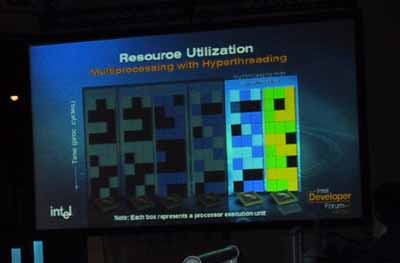Intel Developer Forum - Fall 2001: CPU Report
by Anand Lal Shimpi on August 28, 2001 1:56 PM EST- Posted in
- CPUs
Jackson gets a name: Hyper-Threading Technology
During our Spring IDF 2001 coverage we introduced the idea of Simultaneous Multi-Threading (SMT) architecture being present in the upcoming 4-way Xeon MP processors. Today, Intel put a face with the name and introduced the official marketing name for Jackson Technology/SMT: Hyper-Threading Technology.
There are many types of parallelism that can be achieved on a microprocessor level. Instruction Level Parallelism ensures the simultaneous issuing and execution of instructions. Thread Level Parallelism was previously only attainable through the use of multiple processors which enables the simultaneous execution of threads. A thread is the simplest form of execution that an Operating System can issue to the processor(s) in the system; the inherent limitation being that only a single thread can be sent to a single processor at any given time. The problem with this ends up being that these single threads rarely make 100% usage of the execution power of the CPU.
In order to attain Thread Level Parallelism you'd naturally have to make use of more than one processor since you're limited to one thread executed per CPU at any given time. Another way to execute multiple threads in parallel is by enabling virtual multiprocessing where the OS thinks that your single CPU is actually two or more CPUs and issues it more than one thread to execute. This is what Simultaneous Multi-Threading (SMT) technology enables.
Originally known under the codename Jackson, Intel announced Hyper-Threading technology which is the marketing spin on SMT. We have hypothesized in the past that what is now known as Hyper-Threading technology has been on all of the Pentium 4 dies created up to this point; it was simply not enabled. Hyper-Threading will finally make its debut next year on the 2-way/4-way Xeon processors and hopefully by the end of the year it will transition down to the desktop level in the Pentium 4.
Hyper-Threading requires little more than OS support for multiple thread execution. In this case, OSes like Windows XP Professional will see the single Hyper-Threading enabled processor as being two CPUs.
Intel actually gave a demonstration of the performance improvement offered by Hyper-Threading by comparing a single Xeon processor with HT enabled and disabled. Under Maya 4.0 the HT enabled Xeon processor was able to render a scene 30% faster than the HT disabled Xeon processor. The systems were identical in configuration.

We often complain about the lower IPC of the Pentium 4, but when HT comes down to the desktop level the IPC of the processor will be improved by a potentially very significant margin.
That's all for now…
For us, it's off to a meeting with AMD then NVIDIA (yep, at IDF) and as usual we'll keep you up to date with everything that happens at the conference. Until then, enjoy ;)











0 Comments
View All Comments